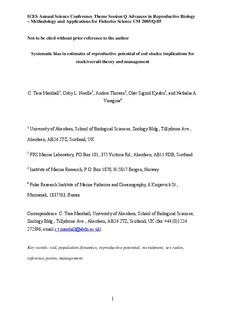| dc.description.abstract | Stock/recruit relationships, describing the relationship between the parental population and the number of offspring produced, are a central tool in population ecology. For fish populations the stock/recruit relationship uses spawning stock biomass (SSB) to represent reproductive potential of the parental population. This assumes that the proportion of SSB comprised of females and the relative fecundity (number of eggs produced per unit mass) are both constant over time. To test these two constancy assumptions female-only spawner biomass (FSB) and total egg production (TEP) were estimated for the Northeast Arctic cod stock over a 56-year time period (1946-2001). During that time period the proportion of females (FSB/SSB) varied between 24 and 68% and the variation was systematic with length such that SSB became more female-biased as the mean length of spawners increased and more male-biased as mean length decreased. Over the same time period, relative fecundity of the stock (TEP/SSB) varied between 115 and 355 eggs g-1 and, like FSB/SSB, was significantly, positively correlated mean length of spawners. Because both FSB/SSB and TEP/SSB covaried with length composition, SSB is systematically biased estimate of reproductive potential. FSB and TEP were evaluated as possible replacements for SSB in stock/recruit relationship. Both indices gave a different interpretation of the recruitment response to reductions in stock size (over-compensatory) compared to that obtained using SSB (either compensatory or depensatory). The threshold level of stock size below which recruitment becomes impaired was estimated for each of the different stock/recruit relationships using piecewise linear regression. There was no difference between SSB and FSB in the assessment of stock status, however, in recent years (1980-2001) TEP fell below the threshold level more frequently than SSB fell below. This suggests that using SSB as a measure of stock reproductive potential may lead to overly optimistic assessments of stock status. | en |
